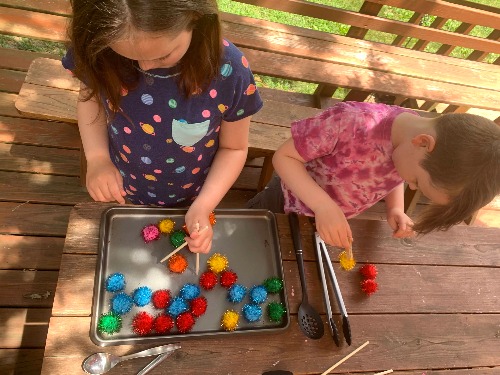Nature Science: Animal Adaptations Activities
Animal Adaptation Activities for Preschoolers
Children are naturally interested in animals, and observing how animals use their adaptations to find food, stay safe, and get around is a great way to hone those important observation skills.
Slow down on the playground
When kids are outside, slowing down and looking around isn’t usually the first thing on their minds. Take a few minutes next time you’re in the backyard or on the playground to make some animal observations. Talk about how to make sure your young scientist isn’t missing anything (or scaring away a potential subject!) they need to be quiet and still. Don’t forget to give small and squirmy animals a closer look too! Find an anthill, flip over a log, and poke around in the dirt for fascinating animals to observe. Don’t forget to bring your nature journal to draw pictures.
Man’s (and everyone else’s, too!) Best Friend
Pets can be a great way to learn about animal features- this includes classroom pets! Turn a snuggle session into a teaching opportunity by looking more closely at whiskers and paws. Take a video of your fishy friend when you go to feed it and rewatch to see amazing adaptations in action. Bring some pillbugs from the garden into the house for a few hours (in a scoop of their dirt!) and watch them use their body to move and stay safe. Make sure to return them to their home. Teachers: for info on classroom pets see the resources below.
Virtual Animal Watching
You don’t need a trip to the zoo to watch amazing animals use their adaptations. Use the internet, and you can watch animals from all over the world show off their survival skills. See the resources below for great places to find child-friendly videos. This is also a great way to go under the sea without a wetsuit. Make sure to watch the video in its entirety before showing it to your littles. It may also be best to play videos without the sound as sometimes commentary may not be family friendly, and background music can be distracting or too scary for younger kiddos.

Bird Beak Bonanza
Supplies Needed:
10-20 objects (beads, buttons, pompoms, cards, pennies etc.) You can use any objects as long as they are around the same size and shape.
Utensils (forks, spoons, ladles, spatula, chopsticks, tongs, etc.)Gather a variety of different sized utensils.
Optional:
Bucket
Hula hoop or cookie tray
Instructions:
- Set up a “feeding ground” for your birds by placing the small objects you have collected on a table top or the floor. Tip: If you have chosen objects that can roll, it might be helpful to use a hula hoop or large cookie tray to keep the food from rolling away.
- Hand each of the bird players a type of utensil. This is going to be their beak for the game. Make predictions together about which beak will make the best beak for picking up the most food quickly.
Exploration Questions: Have you seen a bird eat before? What kinds of things do birds eat? What parts of their bodies do you think they use to eat their food? Can they use a fork and spoon like you?
- Ask the birds to eat the “food” provided with their beaks. Try scooping, pinching, or spearing the food. Tip: if you have a lot of players or the food rolls or can be lost, have each player add the food they’ve caught to a bucket. Call it their stomach!
- Switch food, beaks, or location on the feeding ground and do it all again! Talk about what you learned about what it’s like to be birds with different kinds of beaks.
Exploration Questions: Which beak was the best for picking up which food? Were our predictions correct? What problems did we have while we were “eating”? Can you think of any birds that have beaks that work like any of our utensils? What do they eat?
Older Student Extension:
Add a layer to this activity by starting a conversation about natural selection and inheritable traits. See the resources for information including easy to understand videos and misconception information.
When you’re setting up the activity, make sure to have sets of the same utensil- for example 3 spatulas, 3 ladles, and 3 sets of chopsticks.
Start the game with only one of each of the utensils in play. Explain that your birds are competing for the available food on an isolated island. As your birds eat, keep track of how many pieces of food they have gathered.
Once they have 5 pieces of food, ask them to call out “STOP!” All birds must stop eating. When a bird has gotten five pieces of food, that means they are healthy enough to lay an egg. Add another baby bird to the island. The new bird must have the same type of beak as its mama bird (inheritable traits).
Start the game up again. Continue the game - stopping when a bird has gotten 5 pieces of food and adding baby birds as they are hatched - until all the food is eaten or you are out of utensils.
What happened? Did some birds eat all the food? Is there more of one type of bird with a specific type of beak on the island? Why? Did any birds not have any eggs?
Animal Adaptations Books:
What Do You Do with a Tail Like This? by Steve Jenkins and Robin Page
Creature Features: Twenty-Five Animals Explain Why They Look the Way They Do by Steve Jenkins and Robin Page
Wild Ones: Observing City Critters by Carol L. Malnor
What if You Had Animal Teeth? by Sandra Markle
Grandmother Fish: A Child's First Book of Evolution by Jonathon Tweet
Animal Adaptations Resources:
Pets in the Classroom Resources
https://www.petsintheclassroom.org/benefits-of-classroom-animals/
National Geographic Kids Animal Videos
https://kids.nationalgeographic.com/videos/amazing-animals/
Everything You Need to Teach Evolution
https://www.pbs.org/wgbh/nova/article/everything-you-need-to-teach-evolution/
Additional Product Resources for learning about animal adaptations:
Tree Stump & Forest Animals Set
Watch the Animal Adaptations webinar!
 Hollie is certified K-8 teacher who has been educating in the informal education field since 2005. She has developed and implemented countless exciting STEAM programs for families, classrooms, and teachers focused on the natural world, the scientific process, and ancient life. Her professional passions are inquiry, whole family learning, experiential learning starting in early childhood, and the intersection of literacy and science instruction.
Hollie is certified K-8 teacher who has been educating in the informal education field since 2005. She has developed and implemented countless exciting STEAM programs for families, classrooms, and teachers focused on the natural world, the scientific process, and ancient life. Her professional passions are inquiry, whole family learning, experiential learning starting in early childhood, and the intersection of literacy and science instruction.
She has recently developed a community-based program that encourages families to use dramatic play to learn science, increase literacy skills, and have fun together for which she received the Drexel University Presidential Award for Civic Engagement. She is most proud of her work on a popular science storytelling program for preschool families and classrooms that combines a book club format with engaging programs, innovative curriculum, and a hysterical puppet storyteller.
